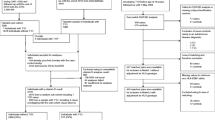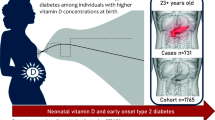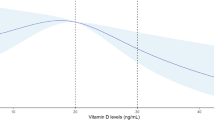Abstract
Aims
To assess whether vitamin D levels at birth were associated with risk of having type 1 diabetes up to 10 years of age and the potential modifier effect of ethnic group.
Methods
The Piedmont Diabetes Registry and the Newborn Screening Regional data were linked to identify cases (n = 67 incident children aged ≤10 years at diabetes onset, 2002–2012) and up to five controls (n = 236) matched for birthday and ethnic group. Cards with neonatal blood spot were used and 25-hydroxyvitamin D(3) assessed with tandem mass spectroscopy.
Results
In conditional logistic regression, OR for unit increment of log vitamin D was 0.78 (95 % CI 0.56–1.10). Vitamin D was significantly lower in migrant than in Italian control newborn babies (p < 0.0001), and interaction between vitamin D and migrant status was statistically significant (p = 0.04). Compared to migrant newborns babies with vitamin D ≥ 2.14 ng/ml, migrants with lower levels had an OR of 14.02 (1.76–111.70), whereas no association was evident in Italians.
Conclusions
Our case–control study within the Piedmont Diabetes Registry showed no association between vitamin D levels at birth and risk of having type 1 diabetes up to 10 years of age, apart from the subgroup of migrant babies, which might have clinical implications if confirmed.
Similar content being viewed by others
References
Forlenza GP, Rewers M (2011) The epidemic of type 1 diabetes: What is it telling us? Curr Opin Endocrinol Diabetes Obes 18:248–251
Mohr SB, Garland FC, Garland CF, Gorham ED, Ricordi C (2010) Is there a role of vitamin deficiency in type 1 diabetes of children? Am J Prev Med 39:189–190
Hyppönen E (2010) Vitamin D and increasing incidence of type 1 diabetes-evidence for an association? Diabetes Obes Metab 12:737–743
Stene LC, Joner G (2003) Use of cod liver oil during the 1 year of life is associated with lower risk of childhood-onset type 1 diabetes: a large, population-based, case–control study. Am J Clin Nutr 78:1128–1134
Sørensen IM, Joner G, Jenum PA, Eskild A, Torjesen PA, Stene LC (2012) Maternal serum levels of 25-hydroxy-vitamin D during pregnancy and risk of type 1 diabetes in the offspring. Diabetes 61:175–178
Miettinen ME, Reinert L, Kinnunen L, Harjutsalo V, Koskela P, Surcel HM, Lamberg-Allardt C, Tuomilehto J (2012) Serum 25-hydroxyvitamin D level during early pregnancy and type 1 diabetes risk in the offspring. Diabetologia 55:1291–1294
Dong JY, Zhang WG, Chen JJ, Zhang ZL, Han SF, Qin LQ (2013) Vitamin D intake and risk of type 1 diabetes: a meta-analysis of observational studies. Nutrients 5:3551–3562
Lehtonen E, Ormisson A, Nucci A, Cuthbertson D, Sorkio S, Hyytinen M, Alahuhta K, Berseth C, Salonen M, Taback S, Franciscus M, González-Frutos T, Korhonen TE, Lawson ML, Becker DJ, Krischer JP, Knip M, Virtanen SM (2014) TRIGR Investigators. Use of vitamin D supplements during infancy in an international feeding trial. Public Health Nutr 17:810–822
Carter GD, Phinney KW (2014) Assessing vitamin D status: time for a rethink? Clin Chem 60:809–811
Powe CE, Evans MK, Wenger J, Zonderman AB, Berg AH, Nalls M, Tamez H, Zhang D, Bhan I, Karumanchi SA, Powe NR, Thadhani R (2013) Vitamin D-binding protein and vitamin D status of black Americans and white Americans. N Engl J Med 369:1991–2000
Bruno G, Novelli G, Panero F, Perotto M, Monasterolo F, Bona G, Perino A, Rabbone I, Cavallo-Perin P, Cerutti F (2009) Piedmont study group for diabetes epidemiology. The incidence of type 1 diabetes is increasing in both children and young adults in Northern Italy: 1984–2004 temporal trends. Diabetologia 52:2531–2535
Eyles DW, Morley R, Anderson C, Ko P, Burne T, Permezel M, Mortensen PB, Nørgaard-Pedersen B, Hougaard DM, McGrath JJ (2010) The utility of neonatal dried blood spots for the assessment of neonatal vitamin D status. Paediatr Perinat Epidemiol 24:303–308
Eyles D, Anderson C, Ko P, Jones A, Thomas A, Burne T, Mortensen PB, Nørgaard-Pedersen B, Hougaard DM, McGrath J (2009) A sensitive LC/MS/MS assay of 25OH vitamin D3 and 25OH vitamin D2 in dried blood spots. Clin Chim Acta 403:145–151
Heath AK, Williamson EJ, Ebeling PR, Kvaskoff D, Eyles DW, English DR (2014) Measurements of 25-hydroxyvitamin d concentrations in archived dried blood spots are reliable and accurately reflect those in plasma. J Clin Endocrinol Metab 99:3319–3324
Cooper JD, Smyth DJ, Walker NM, Stevens H, Burren OS, Wallace C, Greissl C, Ramos-Lopez E, Hyppönen E, Dunger DB, Spector TD, Ouwehand WH, Wang TJ, Badenhoop K, Todd JA (2011) Inherited variation in vitamin D genes is associated with predisposition to autoimmune disease type 1 diabetes. Diabetes 60:1624–1631
Cadario F, Cerutti F, Savastio S, Rabbone I, Tumini S, Bruno G (2014) Italian Society of Pediatric Endocrinology and Diabetology Study Group (SIEDP). Increasing burden, younger age at onset and worst metabolic control in migrant than in Italian children with type 1 diabetes: an emerging problem in pediatric clinics. Acta Diabetol 51:263–267
Mäkinen M, Simell V, Mykkänen J, Ilonen J, Veijola R, Hyöty H, Knip M, Simell O, Toppari J, Hermann R (2014) An increase in serum 25-hydroxyvitamin D concentrations preceded a plateau in type 1 diabetes incidence in Finnish children. J Clin Endocrinol Metab 99:E2353–E2356
Greer RM, Portelli SL, Hung BSM, Cleghorn GJ, McMahon SK, Batch JA, Conwell LS (2013) Serum vitamin D levels are lower in Australian children and adolescents with type 1 diabetes than in children without diabetes. Pediatr Diabetes 14:31–41
Raab J, Giannopoulou EZ, Schneider S, Warncke K, Krasman M, Winkler C, Ziegler AG (2014) Prevalence of vitamin D deficiency in pre-type 1 diabetes and its association with disease progression. Diabetologia 57:902–908
Littorin B, Blom P, Schölin A, Arnqvist HJ, Blohmé G, Bolinder J, Ekbom-Schnell A, Eriksson JW, Gudbjörnsdottir S, Nyström L, Ostman J, Sundkvist G (2006) Lower levels of plasma 25-hydroxyvitamin D among young adults at diagnosis of autoimmune type 1 diabetes compared with control subjects: results from the nationwide Diabetes Incidence Study in Sweden (DISS). Diabetologia 49:2847–2852
Simpson M, Brady H, Yin X, Seifert J, Barriga K, Hoffman M, Bugawan T, Barón AE, Sokol RJ, Eisenbarth G, Erlich H (2011) No association of vitamin D intake or 25-hydroxyvitamin D levels in childhood with risk of islet autoimmunity and type 1 diabetes: the Diabetes Autoimmunity Study in the Young (DAISY). Diabetologia 54:2779–2788
Multiple Sclerosis International Federation (2013) Atlas of MS. http://www.msif.org/includes/documents/cm_docs/2013/m/msif-atlas-of-ms-2013-report.pdf?f=1. Accessed 13 Oct 2014
Ascherio A, Munger KL, White R, Köchert K, Simon KC, Polman CH, Freedman MS, Hartung HP, Miller DH, Montalbán X, Edan G, Barkhof F, Pleimes D, Radü EW, Sandbrink R, Kappos L, Pohl C (2014) Vitamin D as an early predictor of multiple sclerosis activity and progression. JAMA Neurol 71:306–314
Gorham ED, Barrett-Connor E, Highfill-McRoy RM, Mohr SB, Garland CF, Garland FC, Ricordi C (2009) Incidence of insulin-requiring diabetes in the US military. Diabetologia 52:2087–2091
Bizzarri C, Pitocco D, Napoli N, Di Stasio E, Maggi D, Manfrini S, Suraci C, Cavallo MG, Cappa M, Ghirlanda G, Pozzilli P (2010) IMDIAB Group No. protective effect of calcitriol on beta-cell function in recent-onset type 1 diabetes: the IMDIAB XIII trial. Diabetes Care 33:1962–1963
Takiishi T, Ding L, Baeke F, Spagnuolo I, Sebastiani G, Laureys J, Verstuyf A, Carmeliet G, Dotta F, Van Belle TL, Gysemans CA, Mathieu C (2014) Dietary supplementation with high doses of regular vitamin D3 safely reduces diabetes incidence in NOD mice when given early and long term. Diabetes 63:2026–2036
Ferreira GB, Gysemans CA, Demengeot J, da Cunha JP, Vanherwegen AS, Overbergh L, Van Belle TL, Pauwels F, Verstuyf A, Korf H, Mathieu C (2014) 1,25-Dihydroxyvitamin D3 promotes tolerogenic dendritic cells with functional migratory properties in NOD mice. J Immunol 192:4210–4220
Acknowledgments
This study was supported by DeAgostini Foundation. Novara, Italy. Grant Number 2012 and by University of Turin, ex 60 %. Guarantors of the study are Francesco Cadario and Giovanni Bona.
Conflict of interest
The authors declare that they have no conflict of interest.
Human and animal rights
All procedures followed were in accordance with the ethical standards of the responsible committee on human experimentation (institutional and national) and with the Helsinki Declaration of 1975, as revised in 2008 [5].
Informed consent
Informed consent of patients included in the study was obtained by the Piedmont Diabetes Registry and the Newborn Screening Regional Center. The study was reviewed and approved by the Ethics Committee of the S. Giovanni Battista Hospital, Turin.
Author information
Authors and Affiliations
Corresponding author
Additional information
Managed by Massimo Porta.
Rights and permissions
About this article
Cite this article
Cadario, F., Savastio, S., Pagliardini, V. et al. Vitamin D levels at birth and risk of type 1 diabetes in childhood: a case–control study. Acta Diabetol 52, 1077–1081 (2015). https://doi.org/10.1007/s00592-015-0772-6
Received:
Accepted:
Published:
Issue Date:
DOI: https://doi.org/10.1007/s00592-015-0772-6




